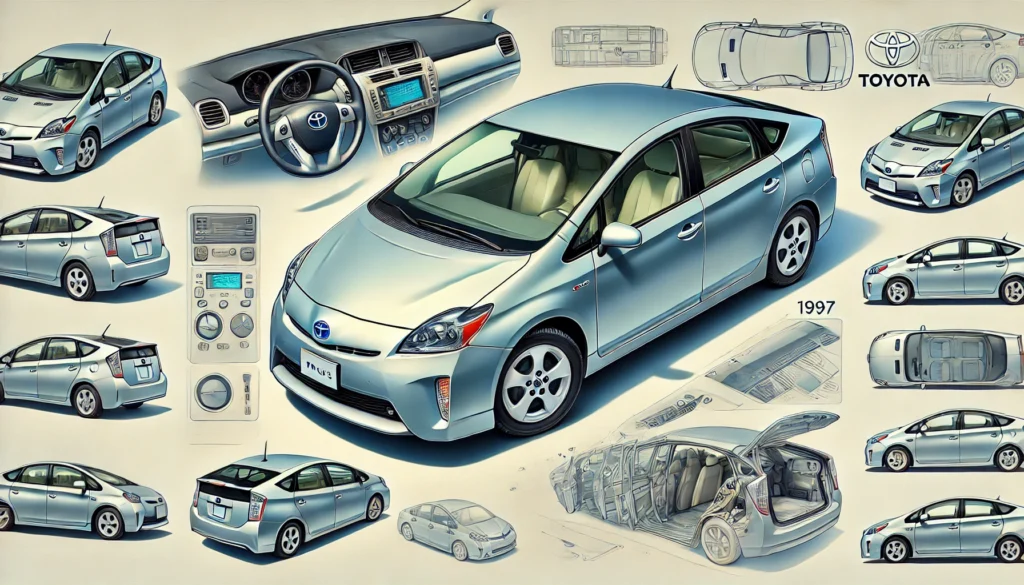The 1997 Prius: A Revolutionary Leap in Automotive History
January 14, 2025
When Toyota introduced the Prius in 1997, it marked a pivotal moment in the automotive industry. Not only was it the world’s first mass-produced hybrid vehicle, but it also laid the groundwork for a new era of eco-conscious transportation. Over two decades later, the 1997 Prius remains an icon of innovation, embodying Toyota’s commitment to sustainability, technological advancement, and forward-thinking design.
The Birth of the Hybrid Revolution
The 1997 Prius debuted in Japan on December 10, 1997. At the time, the automotive landscape was dominated by gasoline-powered vehicles, with limited options for alternative energy sources. The Prius was a bold response to increasing concerns about air pollution, fuel efficiency, and the environmental impact of traditional vehicles.
Toyota engineers worked tirelessly to develop the Hybrid Synergy Drive (HSD) system, a groundbreaking technology that combined a gasoline engine with an electric motor. This dual-power system allowed the Prius to achieve remarkable fuel efficiency while reducing greenhouse gas emissions. With a combined fuel economy of approximately 28 km/L (about 66 mpg in the U.S.), the 1997 Prius set a new standard for eco-friendly vehicles.
Design and Features

The first-generation Prius featured a compact sedan design that prioritized functionality and aerodynamics. Its sleek, rounded shape was not only visually distinctive but also instrumental in reducing drag and improving fuel efficiency. The car’s interior was designed with simplicity and practicality in mind, featuring a futuristic digital dashboard that displayed real-time fuel consumption and energy flow.
Despite its modest size, the 1997 Prius offered a surprisingly spacious cabin, accommodating up to five passengers comfortably. The trunk provided ample storage space, making it a practical choice for daily commuting and family use. Key features included power windows, air conditioning, and an advanced regenerative braking system—a technology that converted kinetic energy into electric power to recharge the battery.
Technological Innovation
What truly set the 1997 Prius apart was its hybrid powertrain. The car was equipped with a 1.5-liter, four-cylinder gasoline engine paired with a permanent magnet AC electric motor. The synergy between these two systems allowed the Prius to operate in three modes: gasoline-only, electric-only, or a combination of both. This flexibility ensured optimal performance and efficiency under various driving conditions.
The Prius also introduced the world to regenerative braking, a system that not only improved fuel efficiency but also extended the lifespan of the brake components. Additionally, the vehicle’s electronic control unit (ECU) managed the seamless transition between the gasoline engine and the electric motor, ensuring a smooth and quiet driving experience.
Market Reception and Impact
Initially, the 1997 Prius was available only in Japan. Its launch was met with skepticism, as many questioned the viability of hybrid technology and its long-term potential. However, Toyota’s commitment to extensive testing and quality assurance paid off. The Prius quickly gained traction among environmentally conscious consumers and early adopters of green technology.
The success of the 1997 Prius prompted Toyota to expand its hybrid lineup and inspired other automakers to develop their own hybrid models. By the early 2000s, the Prius had become a global phenomenon, with subsequent generations building on the foundation laid by the original model.
Environmental and Cultural Significance
The 1997 Prius was more than just a car—it was a statement. It demonstrated that sustainability and innovation could coexist, challenging traditional perceptions of what a vehicle could achieve. The Prius helped raise awareness about the importance of reducing carbon emissions and conserving natural resources, paving the way for the broader adoption of hybrid and electric vehicles.
Culturally, the Prius became a symbol of environmental consciousness and social responsibility. It gained popularity among celebrities, environmental activists, and everyday drivers who wanted to make a positive impact. The term “Prius driver” even entered the lexicon, often associated with individuals committed to green living.
Challenges and Lessons Learned
While the 1997 Prius was a groundbreaking achievement, it was not without challenges. The high cost of hybrid technology made the vehicle more expensive than its conventional counterparts, limiting its initial market appeal. Additionally, early adopters faced uncertainties about battery lifespan and maintenance costs.
Toyota addressed these concerns by investing in research and development to improve battery technology and reduce production costs. Over time, the company’s efforts paid off, resulting in more affordable and reliable hybrid models.
Legacy of the 1997 Prius
Today, the 1997 Prius is celebrated as a milestone in automotive history. It was the catalyst for a global shift toward sustainable transportation, inspiring countless innovations in hybrid and electric vehicle technology. The success of the Prius demonstrated the power of visionary thinking and the potential for collaboration between engineers, designers, and environmentalists.
As the automotive industry continues to evolve, the legacy of the 1997 Prius lives on. Modern hybrids and electric vehicles owe much to the groundbreaking work that Toyota accomplished with its first hybrid model. The Prius set the stage for a future where sustainability is not just an option but a necessity.
Conclusion
The 1997 Prius was more than just a car—it was a revolution. By introducing hybrid technology to the masses, Toyota redefined the possibilities of automotive design and engineering. The Prius challenged conventions, inspired change, and laid the groundwork for a more sustainable future. As we reflect on its impact, it’s clear that the 1997 Prius was not just ahead of its time; it was a glimpse into the future of transportation.